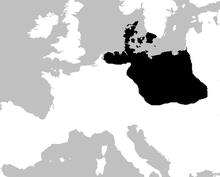Funnelbeaker
 |
|
| Geographical range | Europe |
|---|---|
| Period | Chalcolithic Europe |
| Dates | c. 4300 BC – 2800 BC |
| Preceded by | Ertebølle culture |
| Followed by | Globular Amphora culture, Corded Ware culture |
The Funnel(-neck-)beaker culture, in short TRB or TBK (German: Trichter(-rand-)becherkultur, Dutch: Trechterbekercultuur; c. 4300 BC–c. 2800 BC) was an archaeological culture in north-central Europe. It developed as a technological merger of local neolithic and mesolithic techno-complexes between the lower Elbe and middle Vistula rivers, introducing farming and husbandry as a major source of food to the pottery-using hunter-gatherers north of this line. It was preceded by Lengyel-influenced Stroke-ornamented ware culture (STK) groups/Late Lengyel and Baden-Boleráz in the southeast, Rössen groups in the southwest and the Ertebølle-Ellerbek groups in the north.
The TRB techno-complex is divided into a northern group including modern northern Germany and southern Scandinavia (TRB-N, roughly the area that previously belonged to the Ertebølle-Ellerbek complex), a western group in the Netherlands between the Zuiderzee and lower Elbe that originated in the Swifterbant culture, an eastern group centered on the Vistula catchment, roughly ranging from Oder to Bug, and south-central groups (TRB-MES, Altmark) around the middle and upper Elbe and Saale. Especially in the southern and eastern groups, local sequences of variants emerged. In the late 4th millennium BC, the Globular Amphora culture (KAK) replaced most of the eastern and subsequently also the southern TRB groups, reducing the TRB area to modern northern Germany and southern Scandinavia. The younger TRB in these areas was superseded by the Single Grave culture (EGK) at about 2800 BC. The north-central European megaliths were built primarily during the TRB era.
...
Wikipedia
